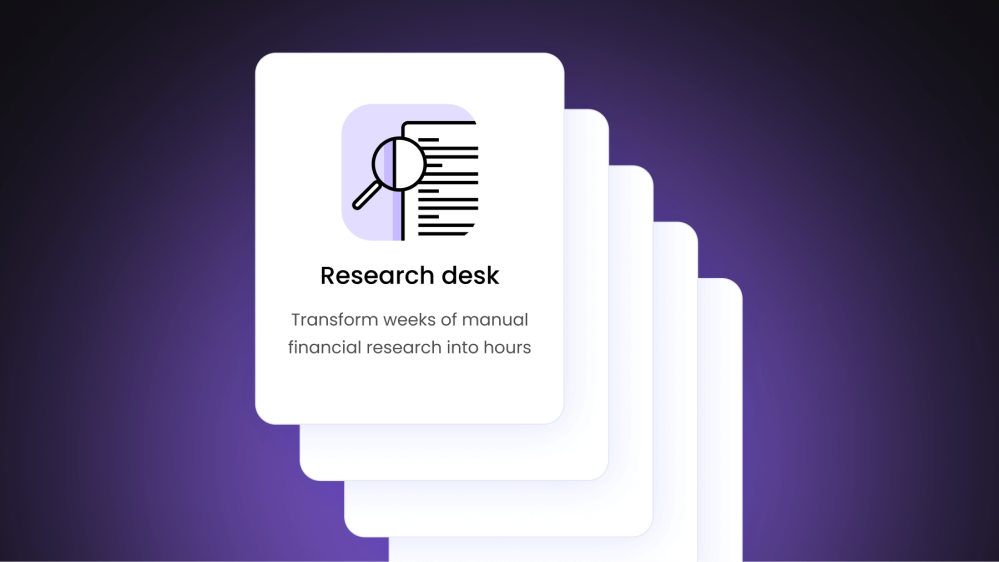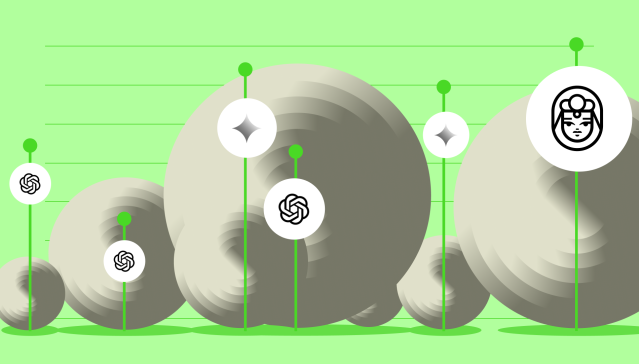AI agents at work
– 16 min read
Alpha, not admin: Reclaiming 70% of your analysts’ time with AI agents

After fifteen years of watching analysts get bogged down in manual data work, I knew there had to be a better way. Here’s how AI agents are redefining financial research, and what that means for your bottom line.
- Traditional financial research processes are manual, time-consuming, and prone to errors, causing analysts to spend up to 70% of their time on administrative tasks rather than analysis.
- AI agents can automate complex, manual analysis, data gathering, and reporting, freeing up analysts to focus on strategic thinking and high-value tasks.
- AI agents should be able to understand plain English commands, automate complex analysis, integrate and synthesize scattered data, and generate ready-to-use outputs such as interactive dashboards and qualitative reports.
- The use of AI agents can lead to improved research quality, reduced analyst burnout, and increased competitiveness by enabling firms to identify opportunities and act faster than competitors.
- The future of finance lies in augmenting human talent with AI agents, enabling firms to scale their research capabilities without increasing headcount and making their analysts more effective.
I must have seen it a thousand times in my 15-year career as a portfolio manager. You have a team of brilliant, highly-paid analysts, but they’re buried under a mountain of data, racing against a market that had already left them behind. Every morning started with the same urgent question, “What happened overnight, and where should we focus our attention?” Getting that answer wasn’t a quick, strategic insight. It was a slow, manual slog — pulling performance figures from one system, cross-referencing risk metrics from another, and piecing it all together just to get a baseline view. By the time we had the full picture, the alpha in the opportunity had often vanished.
It took me years to fully appreciate that the core problem wasn’t our talent. Instead, it was the tools. We were asking 21st-century analysts to work with 20th-century processes, forcing them to spend the vast majority of their time — up to 70% — on the administrative mechanics of financial research, instead of the actual analysis. This basic inefficiency doesn’t just create a frustrating work environment. It leads to delayed insights, widespread analyst burnout, and a persistent competitive disadvantage in a market where speed and accuracy are everything.
That core frustration is exactly why I came to WRITER. I wanted to build the solution I wish I could have given my own teams. I knew that simply throwing more people at the problem was a losing strategy, as was forcing analysts to become part-time programmers. The real path forward is to augment our best people with AI agents that can finally handle the crushing volume and complexity of financial data. This frees up our brightest minds to do the job they came on board for — thinking critically, challenging assumptions, and uncovering the next great investment.

AI agents for financial services: Accelerate financial research from weeks to hours
Read More
Why traditional research processes kill alpha generation
When I talk about that “administrative friction,” I’m not referring to a minor inconvenience. I’m talking about the daily reality that defined my team’s work and consistently undermined our ability to generate alpha. To truly understand the scale of this inefficiency — and the opportunities it cost us — let me walk you through the research cycle I saw play out time and time again.
It always started with the “great data hunt” (1–2 days)
I’d watch my analysts begin every new project with a scavenger hunt. They had to manually pull the latest earnings reports from company websites, swivel their chairs to a Bloomberg terminal for market data, navigate a dozen different broker portals, and then dig through our own shared drives for past notes. Each source was a separate silo with its own sign in and its own unique data format. It was a tedious, fragmented process before we could analyze a single number.
Then came the days of wrestling with spreadsheets (2–3 days)
The next phase was always the most nerve-wracking for me as a manager. My analysts would spend days wrestling with massive, error-prone Excel spreadsheets — painstakingly cleaning data, normalizing formats, and building out valuation models. I knew that a single misplaced formula or a copy-paste error could compromise the entire analysis, creating a constant, low-grade anxiety for everyone. We called it “modeling,” but it felt more like digital plumbing.
From there, it was a slow march to the presentation (3–5 days)
Once the model was ready, the work shifted from analysis to communication. This meant manually creating every single chart, formatting them to fit our presentation template, and then writing the executive summaries to explain the findings. It was a slow, laborious process of turning numbers into a story. I could see it draining the creative energy from my team.
Finally, we’d have the last-minute scramble (1–2 days)
By the time the report landed on my desk, the final review was rarely a high-level debate over the investment thesis. Instead, it was a frantic scramble to double-check calculations, validate data points, and incorporate feedback under pressure. Our focus shifted from sharpening insights to simply avoiding mistakes.
And after all that work — that week-long marathon — the result was almost always the same: The insight was stale on arrival. From where I sat, this inefficiency led straight to missed opportunities for outperformance and a reactive stance in a market that rewards only proactivity.
How AI in financial services delivers the portfolio analysis tools I always envisioned
Whenever my team was drowning, the institutional reflex was always to hire another analyst. I fought for that head count myself, believing that more smart people would solve the problem. But I learned over time that this was just a temporary patch. We were adding more people to a fundamentally broken process, and the administrative burden would inevitably scale right alongside the team. The real solution wasn’t more bodies — it was a better, smarter way of working. We needed to augment our team with an AI tool built for the specific challenges of investment research.
This is why I’m so passionate about what we’re building at WRITER. It is, in every sense, the solution I wish I could have given my teams. It’s a tool designed from the ground up to bridge the gap between a strategic research question and the complex, technical steps required to answer it.
As a former PM, here are the core capabilities I knew it had to have:
- It had to understand our language. I always believed that my team’s value was in their market insights, not their ability to write Python scripts. So, the first thing this solution had to do was interpret plain English commands. I wanted the ability to ask, “Create a PM morning briefing for my portfolio” or “Generate an earnings analysis for Microsoft,” and have the system execute without anyone needing to code.
- It had to automate the complex, manual analysis. I can’t count the hours we lost hunting for a single broken formula in a massive spreadsheet. This tool needed to automate that complex analysis, writing and executing the necessary code to calculate metrics like beta and alpha, or conduct peer comparisons on its own.
- It had to integrate and synthesize our scattered data. The daily scavenger hunt across a dozen systems had to come to an end. I envisioned a tool that could connect to all those disparate sources — market data feeds, internal research notes, company filings — and create a single, unified analysis.
- It had to generate outputs that were ready for us to use. And finally, the output couldn’t be another raw data file that would create more work. I wanted something my team and I could use immediately — feature-rich HTML dashboards and well-structured qualitative reports that were ready for review and strategic debate.
When you put it all together, you can think of it as buying back that 70% of an analyst’s week. The agent handles the mechanics of research — the data gathering, the cleaning, the calculations, the formatting. This is what allows our human experts to dedicate their time and intellectual energy to what truly matters — strategy, critical thinking, and insights that drive portfolio performance.
How to automate a PM morning briefing with AI agents
Let’s make this concrete with a scenario that used to be a regular occurrence for me. I’d come in to find my portfolio was down 50 basis points from the day before. My first request would be direct and urgent, “I need a full briefing by morning on which positions drove the underperformance, what our key factor exposures were, and if there was any market-moving news I missed.”
In the past, that simple request would trigger an all-hands fire drill.
The traditional approach: The data scramble
I’d have to pull a junior analyst off their primary research to begin the scramble. They would spend the next several hours manually pulling performance data from our portfolio management system, grabbing factor data from another provider, and scanning news terminals. They’d then have to synthesize all of it in a spreadsheet, build a few static charts, and drop them into a PowerPoint deck. Best case scenario, that report would land in my inbox around noon — long after the market had opened, and I was forced to make initial decisions with incomplete information.

Generative AI use cases for financial services
Read More
The AI-powered approach: The pre-coffee workflow
Now, let’s run that exact same scenario, but with the AI agent I always wished I had. I would give the agent the same prompt: “My portfolio was down 50 bps yesterday. I need a full briefing by morning on which positions drove the underperformance, what the factor exposures were, and if there was any news I missed.”
Instead of triggering a human fire drill, the agent initiates an automated workflow.
It autonomously connects to the necessary systems to pull portfolio and market data. It performs a performance attribution analysis, identifying the exact positions that drove the negative return. It runs a factor analysis to determine if the underperformance was due to style drift or market shifts. It even scans for relevant news on key detractors. During one of our tests, it encountered a data formatting error from one of the sources, identified the issue, and self-corrected its code to properly parse the file without any human intervention.
Now, before I’ve even finished my first cup of coffee, a complete, interactive “PM Morning Briefing” dashboard is waiting in my inbox.
The breakthrough here isn’t just the speed, though turning a day-long process into a two-hour, automated workflow is transformative. The real shift is moving from a static report to a dynamic analysis. I’m no longer looking at a flat PowerPoint slide. I have an interactive dashboard where I can drill down into specific sectors, analyze different time periods, and ask follow-up questions in plain English, getting answers in real-time. That’s how you move from being reactive to being proactive.
How AI drives alpha and solves for analyst burnout
When I speak with CIOs and Heads of Research today, the conversation quickly turns to the ROI of a tool like this. While the efficiency gains are obvious, the real impact goes far beyond simple cost savings. The most exciting outcomes are the ones that directly affect performance, talent, and the strategic direction of the firm.
Here’s how I frame the business outcomes, based on what I always tried to achieve as a manager.
Direct driver of alpha and competitive differentiation
In our industry, alpha is often a game of inches and seconds. The ability to identify an opportunity and act on it faster than the competition is a massive advantage. When my analysts no longer needed to do the manual data wrangling, they could spend their time on proactive research — scanning for mispriced securities, identifying emerging trends before they become consensus, and developing a deeper, more nuanced understanding of our portfolio companies. This improved research quality and depth leads directly to better-informed, higher-conviction investment decisions. That’s the ultimate competitive edge.
Solution to analyst burnout and the key to attracting talent
I’ve lost great analysts over the years, and it was rarely because the work was too hard. It was because the work wasn’t strategic enough. No one gets a CFA to spend their days copy-pasting data into spreadsheets. By automating the 70% of the job that is tedious and repetitive, you empower your analysts to be the strategists and critical thinkers they joined the company to be. This directly combats burnout by making the role more engaging and intellectually satisfying. It also fundamentally repositions the firm in the war for talent. The best and brightest want to work at places that have the best tools, and this becomes a powerful magnet for attracting and retaining them.
Delivers true scalability and cost optimization
This is how you scale your research capabilities without automatically scaling your headcount. As a manager, this gives you strategic options you never had before. Do you want your existing team to cover a broader universe of stocks, expanding your field of opportunity? Or would you rather they go even deeper on your highest-conviction ideas, strengthening your core portfolio? With this kind of automation, you can do either without needing to double the size of your team. You’re not just making your current process faster, you’re fundamentally changing what your team is capable of achieving.
Will AI replace the investment analyst?
After a recent demo of the agent, a sharp young analyst asked me the question that’s on everyone’s mind, “So, is this going to take my job?”
My answer is always the same, and I give it without hesitation — absolutely not. It’s going to make you better at your job.
I’ve been in this industry long enough to know what makes a great analyst, and it has nothing to do with their ability to format a chart or clean a data set. A great analyst has deep industry knowledge, a network of contacts, the intuition to spot a flawed business model, and the judgment to make a call under pressure. This technology isn’t about replacing any of that. It’s about finally eliminating the 70% of the work that gets in the way — the manual, repetitive, and low-value tasks that burn people out and slow them down.
The future of our industry isn’t man vs. machine. It’s the augmented analyst vs. the traditional analyst. The firms that thrive in the next decade will be the ones that empower their talent with tools that handle the data grunt work. This will free up their people to focus on the one thing they can’t automate — strategic thinking. It allows them to spend more time debating an investment thesis, speaking with company management teams, and understanding the nuances of the market — the very work that builds a durable competitive edge.
From vision to reality: The WRITER research desk action agent
The solution I’ve been describing isn’t just a theoretical concept — it’s the core of what we’ve built at WRITER with our research desk action agent. We’ve taken the exact methodology of augmenting expert analysts and made it an enterprise-ready platform that addresses the unique demands of the financial services industry.
Let me get specific about what this means in practice. Our AI agents:
- Connect directly to your most critical data sources. This isn’t about uploading files. The agent integrates with your data in Snowflake, your market data feeds from Bloomberg and FactSet, and your internal research systems to create a single, unified source of truth for any analysis.
- Autonomously perform complex financial analysis. The agent writes and executes its own code to build financial models, generate tear sheets, calculate DCF valuations, and run comps and precedent transaction analysis — tasks that would typically take an analyst days of manual spreadsheet work.
- Synthesize quantitative data with qualitative insights. It goes beyond the numbers by summarizing earnings call transcripts, parsing the latest broker research, and even analyzing expert interviews to provide a rich, narrative context around the data.
What sets the WRITER approach apart
What makes this possible is that WRITER is a full-stack platform, not just a thin wrapper around a generic model. This is crucial for financial services. Our approach is different because:
- It’s built on our own Palmyra family of LLMs. These are top-performing on benchmarks like the Stanford HELM and are specifically fine-tuned for the language and workflows of finance.
- It’s designed for the enterprise. This means your firm’s security and compliance policies govern every action the agent takes. Everything has a full audit trail, and it integrates with your existing permissioning, so you have complete control.
- It delivers true end-to-end workflow automation. This isn’t just a co-pilot that helps with one step. It’s an agent that can execute an entire multi-step process, like preparing for an earnings call or generating a thematic research report, from start to finish.
From theory to real-world results
This is where the theory becomes reality. Here are real examples of how investment firms are using our AI agents to:
- Reduce manual earnings prep work by automating model updates, summarizing past transcripts, and flagging key topics to watch.
- Compress multi-week thematic research cycles into just a few hours, delivering a comprehensive first draft on a new investment idea.
- Automatically run nightly performance attribution and factor analysis across entire portfolios, so the insights are ready before the market opens.
An invitation to the future of finance
The financial industry is at an inflection point. The old model of using brilliant human minds for manual data processing is no longer sustainable or competitive. Having lived it, I believe that the future belongs to firms that successfully and thoughtfully augment their human talent with agentic AI.
I didn’t leave a 15-year career in finance lightly. I left to bet on this very transformation because I believe in it so deeply. We’re at a rare moment in time where you can either watch the future happen from the sidelines or step onto the field and help build it.
The first step is understanding what’s truly possible when you free your best people to do their best work. I invite you to see exactly how this technology automates the entire research cycle by learning more about WRITER’s research desk action agent. This is a conversation that’s evolving every day, and for those who want to stay at the forefront of this shift, I encourage you to read more of my insights on the future of AI in finance.



